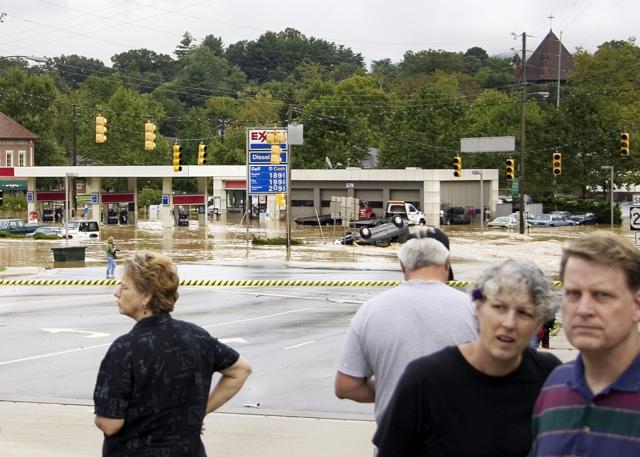“You see how when rivers are swollen … those trees that yield to the flood retain their branches, but those that offer resistance perish, trunk and all.”
— Sophocles
In September 2004, the remnants of hurricanes Frances and Ivan struck back to back, causing flooding and landslides across Western North Carolina. Asheville’s North Fork Reservoir received as much as 20 inches of rain in less than two weeks, according to a UNCA study, forcing Water Resources Department staff to release a large amount of water to avoid potential damage to the earthen dam.
That dramatic surge contributed to the extensive flooding along the Swannanoa River that destroyed roads, bridges, houses and businesses, disrupting the local economy for months. Damage to the 116 businesses in the Swannanoa Valley exceeded $21.9 million, the U.S. Army Corps of Engineers estimated; total property damage was certainly much higher.
Flooding is nothing new here: Over the past century, nine major floods have inundated Asheville, according to the N.C. Geological Survey. And at a Feb. 24 open house, hydrologists from the Renaissance Computing Institute said it’s not a question of if, but when the next one comes along. Meanwhile, future floods are expected to be even bigger, as development creates more impervious surfaces and climate change spawns more severe storms.
The 2006 joint Asheville/Buncombe County Flood Damage Reduction Task Force, made up of government staffers, business owners and residents of affected areas, compiled recommendations and served as an advocate for affected parties; local governments conducted flood risk-and-mitigation studies and developed plans for managing the Bee Tree and North Fork dams during major storms.
In 2009, Asheville, Buncombe County, Black Mountain and Montreat initiated the Swannanoa Flood Risk Management Project, hiring Brown and Caldwell, a Charlotte-based engineering firm, to produce a package of proposals aimed at reducing the impact of the next 100-year flood (see box, “Wet and Wild”). Using the valley’s physical contours to predict flood behavior, the consultants evaluated some 1,100 structures in the floodplain, identifying more than 50 potential flood-management projects. These were whittled down to three core projects projected to reduce future damages by some $80 million over the next 50 years.
By the time those core projects were defined, a plan was also in place for managing reservoir releases in response to major storms. Proposed structural improvements include: rehabbing the Lake Craig Dam at Azalea Park; reshaping a portion of the Swannanoa River around the Biltmore Avenue bridge; and modifying The Biltmore Co.’s Busbee Dam, built on a tributary of Sweeten Creek adjacent to the Blue Ridge Parkway. Also recommended: installing alarms at key locations in the watershed that would sound when flood waters rise.
Meanwhile, a network of rain gauges in the Swannanoa Valley is tied into a broader flood-warning system covering WNC. After the 2004 flood, state funds paid for additional rain gauges plus computerized stations giving staff at City Hall and the reservoir real-time information concerning water levels. That data (which they didn’t have in 2004) should help mitigate flood impacts in populated areas when the next hurricane hits.
Cathy Ball, director of the city’s Public Works Department, says she’s pleased to see these efforts moving forward. The Biltmore Avenue bridge work, she notes, “will be a very sensitive construction project, because of the potential for erosion directly into the stream. When we go out to bid … it will be important for contractors to show that they’ve done projects like this before. We’re not gonna let somebody just come in there with a backhoe.”
Human beings, it seems, have been contemplating how to deal with floods at least since Sophocles. So Asheville’s careful planning for flood mitigation places the city in venerable company.
“We’ve been working on this so long,” continues Ball, “and it’s exciting — people forget, because it’s been several years since the floods.”
— Direct your environmental news to Susan Andrew (251-1333, ext. 153, or sandrew@mountainx.com).




please for the love of god get a better writer. this was awful
that was not nice nick, you better think about your life long and hard..hard..long..so hard.